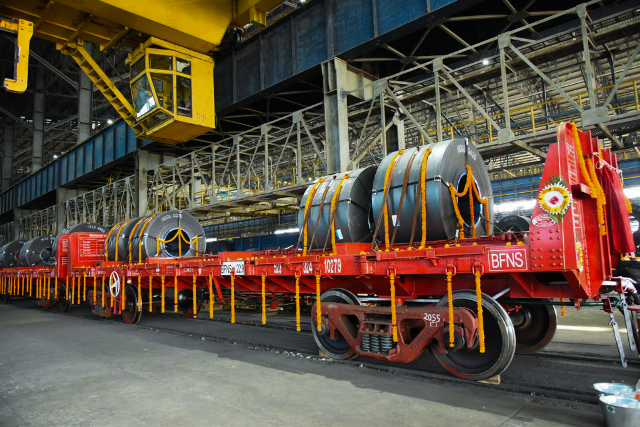by Adhendru Jain, Vice President - Rail and Inland Terminals, DP World Subcontinent
In the quest for sustainability, industries worldwide, are pivoting towards adopting greener alternatives for their operational needs. The steel industry, a cornerstone of the global economy and particularly of importance in the growing Indian market, is no exception. A significant shift is being observed in the adoption of sustainable rail transport for the movement of steel, aligning with global environmental goals and India's commitment to reducing its carbon footprint.
As the second-largest producer of steel globally, India produces more than 100 million tonnes of steel annually,[1]and has an expansive market that demands efficient, cost-effective, and environmentally friendly transport solutions. Currently, around half of India’s steel is transported by road compared to 20-30% globally, however, large players in the country move around 60-80% of their steel via rail. [2]Similarly, the country's logistics sector, historically reliant on road transport, is undergoing a transformative shift towards rail, prompted by the urgent need for sustainability and the visible environmental advantages rail offers. This shift is particularly pertinent in the steel industry, where the bulk movement of raw materials and finished products is a constant necessity.
The Indian Railways, one of the largest and most complex rail networks in the world, has been at the forefront of this transition. Leveraging its extensive reach and capacity, multiple container train operators offer a viable and sustainable alternative to road transport for the steel industry. The move towards rail not only aligns with India's National Steel Policy, aiming for a sustainable increase in production, but also with the national commitments made,under the Paris Agreement to cut carbon intensity by 33-35% by 2030 from 2005 levels.
Rail transportation can reduce emissions by about 60% compared to road transport. This substantial reduction in carbon emissions is crucial for the steel industry, given its traditionally high carbon footprint. Addressing the steel industry's logistical challenges, particularly in transportation, presents a critical concern given the disruption in the supply of metallurgical coal, affecting steel production and prices. Despite abundant iron ore availability, the procurement of coking coal remains a hurdle. The specific handling needs of steel and its raw materials, coupled with the landlocked sites of numerous Indian steel plants, limit access to ports. This emphasizes the need to explore alternative transportation methods. In this context, railways emerge as the most economically feasible option.
Opting for rail transport not only addresses these challenges but also aligns with sustainability goals, offering a greener alternative compared to other modes of movement. Rail transport significantly reduces environmental impact, showcasing lower energy consumption and emissions per tonne-kilometer. Moreover, the consolidation capacity of rail transport minimizes the number of trips required to transport cargo, further enhancing its environmental efficiency. By embracing rail as a solution, the steel industry takes a substantial stride towards sustainable logistics, mitigating the environmental footprint of one of the most resource-intensive sectors.
The interim budget for 2024-25 announced plans to execute three Economic Railway Corridors under the PM Gati Shakti initiative. These corridors aim to enhance logistics efficiency and reduce costs associated with rail movement in the country. At the same time, they can also enable the decongestion of high-density rail routes and promote multi-modal connectivity, ultimately contributing to a reduction in carbon footprint within the logistics sector. For the steel industry, it means not only reduced carbon emissions but also cost efficiencies, enhanced supply chain reliability, and a significant step towards sustainability. For India, it represents progress towards its environmental goals, economic growth, and a leadership position in green logistics on the global stage.
Multimodal logistics, bolstered by initiatives such as the PM Gati Shakti project and Port Connectivity Corridors, promise significant benefits for the steel and other industries. By integrating various modes of transportation and enhancing port-led development, these efforts will streamline supply chains. Overall, these approaches work towards achieving greater efficiency and competitiveness in the transportation of raw materials and finished goods, ensuring a sustainable future for industries reliant on efficient logistics.
[1]https://steel.gov.in/en/make-india#:~:text=Introduction,period%20last%20year%20(CPLY).
[2]https://economictimes.indiatimes.com/industry/indl-goods/svs/steel/centre-plans-to-optimise-movement-of-iron-ore-and-steel/articleshow/103698558.cms?from=mdr






